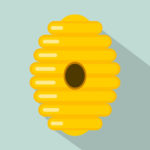
People frequently lump all stinging insects into the same category but Baldfaced Hornets present certain dangers. Warm summer weather is when they’re active so it’s important to be careful and know what to watch out for.
What Are Baldfaced Hornets?
Also called “whitefaced hornets,” “white-tailed hornet,” “baldfaced yellowjacket,” “bull wasp” and “blackjacket,” baldfaced hornets are actually a type of yellowjacket, not a hornet. Despite that, they aren’t yellow at all but instead have large black bodies with white markings on the tip of the abdomen and predominantly white faces.
Are Baldfaced Hornet Nests Football-Shaped?
It’s possible you’ve seen a baldfaced hornet nest without seeing the insects, especially empty ones in the winter or nests in trees that are only noticeable after they’ve lost their leaves. Baldfaced hornet nests are large, shaped like footballs and made of wood pulp that looks like brittle paper. They can reach a size of three feet as the colony expands and grows.
In the spring, a baldfaced hornet queen emerges from winter hibernation in a tree hollow, attic, etc. to build a small nest, about the size of a baseball, in a protected space, like high in a tree. She makes the nest by chewing bark and rotten wood. The combination, mixed with the queen’s saliva, creates a paste the queen uses to create a small, paper-like nest with interior cells similar to a honeybee’s comb. She lays eggs in the nest to create the first batch of workers. They will takeover nest building and food production while the queen focuses on egg production. A colony tends to grow until there are up to 400 workers.
At the end of summer, the queen will produce fertile male and female eggs, which lead to the production of new queens who will seek out safe hibernation spaces for winter. The rest of the colony, including the old queen, will die.
Are Baldfaced Hornets Dangerous?
Baldfaced hornets are very territorial and will sting anyone who comes too close to their nest. Because they can sting over and over, agitating baldfaced hornets is very dangerous, and simple proximity to their nest can antagonize them. In addition to the pain from the sting, their venom triggers pain receptors, inflammation and sometimes even allergic reactions.
Fortunately, if encountered away from their nests, baldfaced hornets tend not to be aggressive. However, if a nest is near your home or, worse, near your entrance, you could easily become a target of baldfaced hornets.
In general, baldfaced hornets nest high in trees, lowering the risk of interaction. They’re also considered “beneficial insects” because they eat flies, mosquitos, aphids and other insects that can be pests. However, if you’re allergic to stings or the nest is in the walls, close to your home, etc. getting rid of the nest is essential.
Can I remove Baldfaced Hornets?
It’s tempting to grab a can of wasp and hornet killer and tackle them yourself. That can be very dangerous for several reasons:
1) The Spray Is Too Slow
Even though labels may say “Immediate Knockdown Power” or “Kills on Contact” hornets can often still fly short distances and attack after being sprayed.
2) Spray Distance Is Too Short
Even when the can says it can shoot up to 27 feet, spray streams generally lose cohesion at half their total distance, making it difficult to hit the target. Long spray streams also tend to have an arc rather than being a straight line, which also makes targeting difficult.
3) You Must Spray Inside the Nest
Just spraying the exterior of the nest isn’t enough. On the contrary, that’s likely to just antagonize them. To effectively kill a baldfaced hornet nest, you have to spray inside the opening of the nest, which is dangerous. Worse, some do-it-yourselfers suggest getting the spray nozzle right into the opening in the hopes that the spray will block hornets from escaping and stinging you. The only problem is getting close enough to do that puts you at high risk for being stung.
4) Using the Wrong Spray
Wasp and hornet killers have different formulas than a mosquito or ant spray. Using the wrong one will only make the hornets angry and get you stung.
5) The Spray Is Dangerous to You
Commercial bug killer labels are covered with warnings about not getting spray in your eyes or on exposed skin. An accident could have severe consequences – and if you agitated the nest and have hornets chasing you, it would be all too easy to accidentally get spray vapor in your eyes, etc.
6) Fire or Gasoline Are Not a Solution
Some DIYers advocate pouring gasoline, petroleum or kerosene in a nest. That’s dangerous if a spark sets it off, environmentally unsound and a hazardous solution with more drawbacks than benefits. Don’t do it. Don’t even think of doing it.
Let Arrow Exterminating Help
The smartest way to get rid of baldfaced hornets is to call a professional like Arrow Exterminating. We’ll start by properly identifying the type of insect, finding all of its nesting areas and removing it. Why risk painful, dangerous stings when the experts at Arrow can do it for you? If you think you have a hornet or yellow jacket problem, contact Arrow Exterminating to identify and eliminate them.





